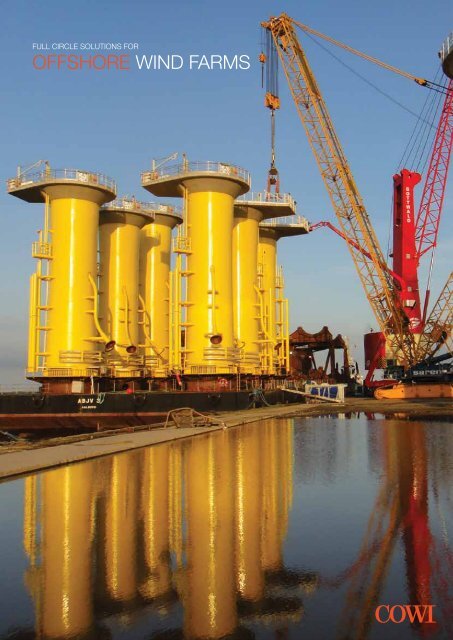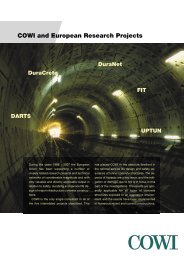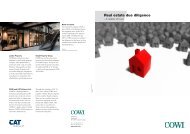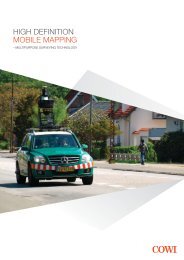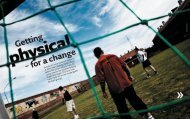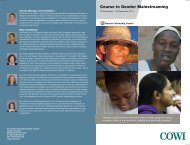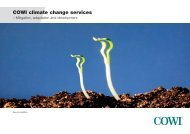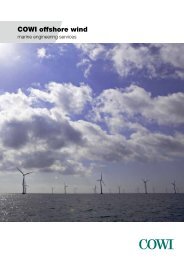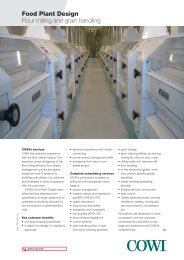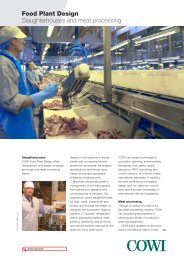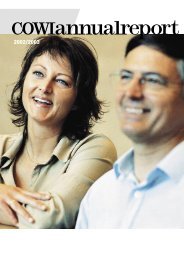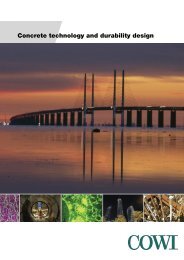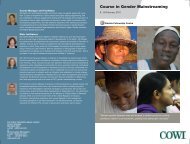oFFshore Wind Farms - Cowi
oFFshore Wind Farms - Cowi
oFFshore Wind Farms - Cowi
You also want an ePaper? Increase the reach of your titles
YUMPU automatically turns print PDFs into web optimized ePapers that Google loves.
Full circle solutions foroffshore <strong>Wind</strong> farms
offshore <strong>Wind</strong> farm 3content4 Introduction6 Site screening andfeasibility studies8 Met mast and windresources10 Environmental impactassessment12 Metocean studies14 Marine geophysics andunexploded ordnance16 Marine geotechnics18 Foundation designs20 Foundation design forThornton Bank phase 122 foundation design forLondon Array24 Marine Structures Risk andProbabilistic Analyses26 Cable engineering androuting28 Offshore substations30 Monitoring and inspectionof existing structures
COWI staff visiting a mock-up.
offshore <strong>Wind</strong> farm 5IntroductionCOWI is a highly versatile and multidisciplinary company operating worldwidefrom more than 35 international offices.COWI’s expertise within offshore wind farm projects stands on the shouldersof our experience developed since 1930 within foundations for large bridges,offshore oil and gas developments, power systems and marine structures.COWI offers multidisciplinary and diversified consultancy and we draw on indepthexpertise for the wide range of disciplines required, which have successfullybeen applied to a wide range of offshore wind farm projects.COWI offers a broad range of services within every project phase involved inan offshore wind development. Our 360° approach takes lots of expertise.Fortunately, we have the people to back it up.decommisioningFULL CIRCLE solutionoffshore windoperation,inspection andmaintenenceconstructionideaThe purpose behind this full-circlesolution is to minimize the project risk byoffering a simple and coherent approachby which we support our clients inachieving the expected high qualityresults within budget and on time.design
Technical installations chart for the feasibilitystudies of offshore wind farms in the Øresund areain Denmark.
offshore <strong>Wind</strong> farm 7Site screening and feasibilitystudiesChart of the vessel traffic in the area ofthe Øresund.Screening processThe purpose of the screening process is toidentify sites where locations for offshorewind farms would be feasible and have theleast possible environmental impact onnature and humans. The following issueshave to be taken into consideration:››<strong>Wind</strong> energy resources››Grid connection››Hydrography››Environment and raw materials››Sea cables››Navigation››Visual impact.Conceptual designThe conceptual design phase aims at selecting the best suited technicalfoundation solution for each wind farm location and characteristics. A basis forthe economic assessment of an offshore wind power plant is established andthe costs are divided into:››Construction costs for foundations, wind turbines, power system and gridconnection››Operating and maintenance costs.Selected references››Screening of offshore sites in theØresund area in Denmark for300 - 400 MW offshore windfarms››Site identification for 100 MWoffshore wind farm in BohaiBay in China››Assessment of the potentialfor offshore wind farms alongthe Portuguese coast››Conceptual design of 300 MWoffshore wind farm in Øresundin Denmark››Identification of potentialoffshore wind farm in theDanish territorial waters››Development of wind farmlayout, wind power calculations,conceptual design offoundation structures andcable grid. In addition,estimate the total wind farmcost for two offshore areas inthe Øresund area in Denmarkand calculate the unit cost perkWh.Feasibility studyThe purpose of the feasibility study is to assess the economic feasibility of anoffshore project based on the conceptual design and the available wind energyresources. The results of the feasibility study include calculation of the productioncosts per kWh and assessment of economic and technical risks duringimplementation and operation.
Met mast and wind resourcesCOWI carries out offshore wind measurements with standard equipment such asanemometers on lattice towers and Lidar’s. We are one of the Measnet foundersand one of the few companies accredited for IEC61400 and Measnet qualitymeasurements.We supply high quality analysis and combine measurements with wind resourcestudies. We also supply site specific wind data input for the design basis forwind turbines and foundations.Our services include:››Initial evaluation of wind energy resources››Planning and execution of site-specific wind energy resource investigations.››Analyzing site-specific data and preparing detailed wind energy resourcestudies››Micro-siting using state of the art software packages››Calculation of energy production››Second opinion on wind studies and micro-siting.We offer measurements of movements and loads of grout-connections betweenmonopiles and transition pieces for offshore wind turbines. We base our adviceon 30 years of experience with structural measurements on wind turbines, andload calculations with aeroelastic wind turbine codes.
offshore <strong>Wind</strong> farm 9Selected references››Met mast installation to gatherdata for optimising the foundationdesign of the 500 MWGreater Gabbard Offshore<strong>Wind</strong> Farm off the coast ofSuffolk in UK››Measurement equipmentincluding strain gauges on thefoundation have been installedon an offshore wind turbine atNysted Offshore <strong>Wind</strong> Farm inDenmark and several analyseshave been carried out in orderto determine the loads on theturbine caused by waves andwind.Met mast installed by COWI.We provide high quality analysis of our measured data or of client’s data. This isat times a requirement by a certifying body, and sometimes a comforting meansof control for the operator and owner of a wind farm.COWI has been involved in offshore wind farm layout configuration from the verybeginning. Offshore wind farms are fundamentally different from onshore in thesense that there is no terrain and roughness.From a wind perspective the challenge is to make the optimum grid (layout) andspacing in order to optimize losses due to wakes. Offshore wind farms consistof multiple rows and estimation of deep array losses is crucial for a reliable AEPestimate. Virtual roughness, where appropriate, is modelled when estimating thedeep array losses. COWI has gained expertise in modelling deep array lossesand using wake models to optimise specific locations. The relevant economicoptimisation when preparing layout for offshore wind farms combines foundationcosts, cable-costs, electrical losses in cables and lifetime value of electricaloutput. Non-economic issues like sailing routes, visual impact and environmentalconcern also need to be considered.
offshore <strong>Wind</strong> farm 11EnvironmentalImpact AssessmentA thorough environmental impact assessment (EIA) is a mandatorycomponent in any offshore wind farm project. Based on our extensiveexperience COWI applies comprehensive EIA procedures accordingto contemporary international standards and the environmentalstandards of the funding entity.A specific EIA may be preceded by a strategic environmental assessment(SEA) for a regional offshore wind power development plan.COWI has wide experience of conducting SEAs for planning authoritiesby deploying planners as well as environmental and regulatoryspecialists. Our strong international network with partners, institutionsand organisations enables us to obtain complete data and informationof importance for conducting a comprehensive EIA.A thorough mapping of environmental sensitivity is essential as a partof securing a complete environmental baseline.COWI can develop environmental risk models, which take intoaccount hydraulic features and oceanographic parameters necessaryfor creating a trustworthy picture of the dynamic environment at agiven wind farm site.An integrated and important element in our approach to environmentalassessments is the attention we give to interdisciplinarysolutions. Due to our broad in-house competencies we can challengepossible technical and environmental problems and find suitableand sustainable solutions, which can be approved by engineers,socio-economists and environmentalists – and meet the needs ofour clients. Typical interdisciplinary issues comprise sustainabilityschemes (inclusive of cradle-to-cradle analysis), health, safety andenvironment (HSE) issues at construction sites and at the operatingwind farms.“Also, fish spawning areas and theoccurrence of marine mammals areenvironmental elements of very highsignificance – and candidates forpotential conflicts when locating andestablishing wind farms.”Selected references››Environmental impactassessment of the fielddevelopment of the Nini andCecilie and 10 prospects inthe North Sea. Our servicesincluded technical descriptionsof the facility during theextension, production anddismantling/removal phases, adescription of the environmentin the affected area, andenvironmental consequenceassessments for each phaseof the project››Update of environmentalimpact assessment of furtherdevelopment of existing oiland gas fields in the North Sea››Performance of marinemonitoring around thedevelopment of the artificialisland in Qatar (the Pearl of theGulf) to evaluate the effectsaccording to authorityrequirements.
Metocean studiesCOWI offers the complete service with respect to metocean studies for offshorewind developments. We analyse meteorological and oceanographical data anduse numerical wave and hydrodynamic modelling state-of-the-art-software todefine design water levels and wave conditions at each site.Site specific metocean studies are performed to establish hydraulic designconditions for offshore wind farms. The studies are presented in report formproviding a general description of the area in question including seawaterproperties, such as salinity, temperature and density variations. Baseline data forthe study are presented. Such data typically comprise measured or hind-castedwind, waves, water levels, currents and atmospheric pressure.
offshore <strong>Wind</strong> farm 13Hydrodynamic modelling of waves, current and water levels forms a key part ofthe metocean study. COWI applies the state-of-the-art DHI MIKE hydrodynamicmodelling suite. Wave conditions are modelled by use of MIKE21 SW, typicallyfor durations of 10 to 20 years to allow full statistical analysis of design conditions.Normal and extreme current speed as well as tidal levels and storm surgesare derived from hydrodynamic modelling MIKE21 HD for periods covering a fullyear and selected storm events.Statistical analysis forms the second major part of the metocean study. Thisanalysis includes extreme statistics, scatter tables and joint probability analysisdirectly applicable to the load cases of the IEC-61400-3 standard.COWI applies time and spatially distributed wind and pressure fields as forcing ofthe models. Wave boundary conditions are provided from regional/global wavemodels. Model bathymetry is derived from the global sea chart database MIKEC-MAP combined with site specific surveys. In combination, the global availabilityof such data allows us to perform metocean studies for any site, typicallywithin 3 months from receipt of client-specific data.Scour and scour protectionSeabed/structure interaction in terms of scour, backfilling and scour protectionis presently an area of intense research. COWI maintains very close contact withuniversities and research institutions within this field and contributes to developmentof design approaches. COWI has extensive experience of both deskdesigns of scour protection and planning and supervision of physical modeltests.Selected references››Analysis of metoceanconditions including wind,waves, currents and waterlevels and preparation of thepreliminary design basis forthe gravity based foundationfor the Storgrundet Offshore<strong>Wind</strong> Farm located in Swedishterritorial waters in thesouthern part of the Gulf ofBothnia. For the given sitethree layouts of turbinepositions, comprising 46, 56and 70 wind turbinegenerators located in waterdepths from 10.5 m to 27.5 mare envisaged with 3 MW to 5MW wind turbines››The metocean study for theoffshore wind farm ARCADISOst 1 in Germany includedsalinity, temperature, density,seasonal variations, wind,wave, water level time series,misalignment plots andextreme analysis››Metocean study andpreliminary design basis forSuurhiekka Offshore <strong>Wind</strong>Farm in Finland.
Marine geophysics andunexploded ordnanceThe results of the geophysical survey together with the geotechnical investigationsgive the geological information needed to design the most cost effectivesolution for the foundations.COWI reviews the existing information in order to prepare a comprehensiveinvitation to tender (ITT), introducing the basic requirements, best practises andlegal terms, to allow an efficient contractor selection process, in which we alsoassist our clients. COWI distributes the ITT to qualified bidders, reviews proposals,gives advice on the contractor selection and starts managing the relationshipwith the client-selected contractor.After the contract award COWI manages the relationship between client andcontractor, reviews and ensures the quality of all project preparation documentationsuch as quality and health, safety and environment (HSE) plan anddocumentation.
offshore <strong>Wind</strong> farm 15COWI optimises the survey proposed by the contractor in order to minimisethe survey time (i.e. optimising the number of lines and turns) while maximisingsafety and data gathering performance by supporting the simultaneousacquisition of all required data, which normally comprise bathymetry (multibeamechosounder), acoustic imaging of the sea bed (side scan sonar), verticallayering of the seabed (sub-bottom profiles) and detection of possible metallicobstruction on the seabed (magnetometer).Acting as the client’s consultant during calibrations, data acquisition and withoperational safety assistance, COWI adds value to the survey performance.After the survey COWI manages the relationship between the client and thecontractor and deals with all required negotiations.Finally, COWI checks the data processing, charting and reporting in order toguarantee that final deliverables meet the required quality. The deliverables willbe focused on:››Supporting the selection of a minimum number of locations to perform geotechnicalinvestigations and characterise the area››Supporting the creation of a geological report.Unexploded ordnance (UXO) surveyCOWI offers support on managing the risk of potential UXO in relation to jack-uprigs and cable installation operations. Our services include:››Comprehensive risk assessment as a basis for possible UXO surveying and tocomply with local legislation and the client’s HSE requirements››Design, survey and mitigation (if needed).Selected references››Preparation of invitation totender for marine geophysicalsurvey to support decisionmaking on the route selectionfor the export cable anddetailed post-processing ofmagnetometer survey resultsfor unexploded ordnancedetection for the AnholtOffshore <strong>Wind</strong> Farm inDenmark››Planning and survey design,CPT investigations for exportcable for the West of DuddonSands Offshore <strong>Wind</strong> Farm inUK››Client’s consultant andrepresentation before, duringand after the survey for theWikinger Offshore <strong>Wind</strong> Farmin Germany››Quality check and assuranceof survey data (regular seabedmapping) and UXOassessmentson the LondonArray Offshore <strong>Wind</strong> Farm inUK.For the Wikinger Offshore<strong>Wind</strong> Farm the surveyredesign represented animportant reduction of thesurvey time.
Copyright: London ArrayJack-up risk assignmentsCOWI has carried out risk evaluationregarding the sea bed conditions forjacking up on a number of offshorewind turbine sites. The risk assignmentfocuses on: Existence of objects on theseabed surface or metallic objects inthe sub-surface, which could compromisethe operation, sea bed conditions,bearing capacities and penetration offootings, risk of punch through of softerlayer below footing, and other groundrelated risks in conjunction with jackingup operations. All the previous assessmentsare carried out with geophysical(i.e. AUV) and geotechnical solutions.
offshore <strong>Wind</strong> farm 17Marine geotechnicsCOWI supplies all necessary geotechnical engineering services:››Preparation of tailored tender documents for investigation programmes››Proposal evaluation››Supervision of geotechnical investigations››Specification and interpretation of field and laboratory tests, including CPTU,triaxial tests and consolidation tests››Preparation of design bases for foundation design››Conceptual and detailed design of all types of foundations for offshore windturbines and transformers››Advanced analysis, including 2D and 3D finite elements modelling.››Leg penetration analyses for jack-ups including punch-through analyses (incombination with geophysical results)››Preparation of tender documents for construction››Follow-ups on project execution.COWI has a vast experience working with gravity foundations and monopilesusing in-house design tools to ensure optimal design. COWI has also a broadexperience, obtained in the oil and gas sector, designing jacket foundations.These are increasingly expected to be the preferred foundation type for deeperwaters.COWI carries out advanced 2D and 3D finite elements modelling of foundationsto clarify the complicated interaction between soils, foundation and wind turbinein operation.Selected references››Supervision assistance to soilinvestigation for foundationsfor 23 offshore wind turbinesfor Thornton Bank phase 2 inBelgium››Supervision assistance to soilinvestigation for 12 locationsto characterise the area forWikinger Offshore <strong>Wind</strong> Farmin Germany››Supervision assistance to soilinvestigation for foundationsfor more than 100 windturbines for Wikinger Offshore<strong>Wind</strong> Farm in Germany››Supervision of the detailed soilinvestigations for the West ofDuddon Sands Offshore <strong>Wind</strong>Farm including 140 windturbines and one substation inUK››Supervision of geotechnicalinvestigations containingboreholes and CPTs fromjack-up for the offshore windfarm just east of Frederikshavnwith 5 wind turbines. COWI isacting as client’s representative.Additionally COWI is continuously gathering information on new foundationtypes, which might provide the appropriate solution for our client’s developments(i.e. bucket foundations).
foundation designsSelected references››Detailed design of monopilestructures for 175 foundationsequipped with Siemens 3.6 MWWTG for London Array with630 MW in UK››Detailed design of monopilestructures for 80 foundationsequipped with Siemens 3.6 MWWTG for DanTysk with 288 MWin Germany››Detailed design of gravitybased foundation structuresfor 16 foundations equippedwith Vestas 3.0 MW WTG forKårehamn with 48 MW inSweden››Detailed design of gravitybased foundation structuresfor 5 foundations equippedwith RePower 5 MW WTG forThornton with 30 MW inBelgium››Detailed design of 90 gravitybase foundations for 2.3 MWwind turbines for the RødsandOffshore <strong>Wind</strong> Farm inDenmark››Detailed design of 72 gravitybase foundations for theNysted Offshore <strong>Wind</strong> Farm inDenmark.Together with our clients, COWI participates in the development of offshore windfarm foundation projects from the outset and through all phases of the project.We develop the foundation designs from the initial conceptual stages, where theoptimal type of foundations for the project are determined, through the detaileddesign phase and supervision and monitoring of the installed and completedstructures. Our services include assessments of foundation types in the contextof overall project returns based on wind resources, make of turbine, geotechnicaland hydraulic conditions etc. to ensure that each project foundation isoptimized to the site and requirements of our clients.Our design experience within offshore wind farm foundations has been obtainedover many years since the early start of the offshore wind farm industry in the1980s. Our concepts and designs have set the standard over the years. Ourdesign experience for detailed design of offshore wind farm foundationsincludes:››Steel monopile foundations››Concrete gravity based foundations for shallow water depths››Concrete gravity based foundations for deep water depths.For tender, concept and preliminary designs our experience includes:››Jacket structures››Tripod foundations››Bucket foundations.The early stage design projects are based on our comprehensive design experiencefrom the marine offshore industry of both terminals and oil & gas.The key to a successful offshore wind farm design project is always the actualand comprehensive project experience. Only through actual and comprehensiveproject experience can the proper handling of the complex interfaces betweenthe contractors, clients and third parties be obtained. This is where a designer’sinput can be the key to the early handling of decisions that will later provedecisive for optimal project execution and hence optimal project returns.It is also the actual project experience in combination with the necessary level ofqualifications that ensures that an optimal design solution is found for contractorsand clients alike within the constraints of time and resources.COWI can provide the experience, the competence and the necessary flexibilityin staff resources to ensure that our projects are undertaken carefully, diligentlyand with an optimal outcome for our clients.COWI uses state-of-the-art numerical FEM programmes for the analysis anddesign of foundation structures. We have established an integrated platform foran expedient execution of our calculation models and hence we can executelarge and comprehensive design projects efficiently.For concrete structures, we use our in-house FEM program IBDAS, whichprovides advanced modelling features for pre-stressed concrete structures,taking into account fatigue in both reinforcement and concrete.
offshore <strong>Wind</strong> farm 19
offshore <strong>Wind</strong> farm 21Thornton Bank phase 1Foundation designCOWI carried out the detailed design of the foundations for Thornton Bankphase 1, which comprises 6 turbines, totalling, 30 MW.The wind turbines are founded at -21.5 m to -27 m TAW and soil conditionsare generally sand of medium grain size. The pre-stressed concrete foundationstructure is composed of a cylindrical shaft on top of a conical base transferringthe loads from the wind turbine directly to the base slab.The base diameter is 23.5 m and the shaft diameter is 6.5 m, matching thediameter of the turbine tower.The foundation structures are prefabricated on land, and installed at sea bya heavy lift crane, on a pre-installed gravel bed. The weight of the concretestructure is about 2,700 tonnes.
London Arrayfoundation designWith 175 monopiles, designed to carry the Siemens 3.6 MW turbines, theLondon Array will be the largest offshore wind farm in the world, when completedin 2012. Monopiles of 4.7 m and 5.7 m in diameter are being installed inwater depths between 0 m and 25 m. With a total length of up to 85 m, thesefoundations will be amongst the largest ever built.A consortium of DONG, E.ON and Masdar has commissioned Aarsleff |Bilfinger Berger Joint Venture (ABJV) as contractor to undertake fabricationand installation of the steel foundations. To carry out the detailed design of thesteel foundations, ABJV has engaged COWI as lead in a joint venture with IMSGmbH, COWI-IMS JV.The offshore wind farm is located on and between the sandbanks of KentishKnock and Long Sand representing depth variations of up to 25 m. The soilincludes both sand profiles, stiff London Clay profiles and mixtures including alsogravel layers. With layers potentially prone to liquefaction, also the soil representsa challenge to the design.The project will be one of the first to introduce a new design of grouted connectionsand improvements in the geotechnical calculations of soil structureinteraction to allow for an optimised design.The present project constitutes the first phase of a two-phased set-up and isexpected to deliver 630 MW of electricity.Copyright: London Array
offshore <strong>Wind</strong> farm 23
Copyright: Søren Gammelmark
offshore <strong>Wind</strong> farm 25Marine StructuresRisk and ProbabilisticAnalysesPlanning, design, construction, operation and decommissioning of marinestructures opens up a vast field of different risk sources. These can be analysedand handled accordingly with help of probabilistic analysis. COWI is experiencedin risk assessment and mitigation in all project phases.An indispensable part of the metocean study is evaluation of extreme values andjoint probabilities of environmental conditions, providing a basis for design andfurther allowing evaluation of the structure’s reliability. COWI’s expertise can beseen at the leading edge of current developments and application of extremeand joint probability analysis, and is already applied in different projects all roundthe world.One of COWI’s specialties is the ship risk analysis. Based on studies of the shiptraffic pattern in a certain region the risk due to ship collision with any kind ofmarine structure can be evaluated at a sophisticated level. This is essential notonly to evaluation of damage or collapse risk of marine installations, but alsoto the risk of environmental impact due to ship cargo spills. Further, re-/routingof ship traffic and navigational risks should be emphasized in the variety of riskanalysis performed by COWI in relation to ship risk.Already during the design phase it is essential to gain knowledge on the constructionand the operational risk. This not only guarantees a reliable structurewith acceptable risks to users and third party, but also allows for an economicoptimization of the design taking further life cycle risks into account. COWI hasextensive experience in construction and operational risk analysis and incorporationof the these results during the design phase. This has allowed COWI tobuild and maintain all different types of marine structures in a very economic andefficient way.End-of-life decisions involving decommissioning options are another specialistarea in which COWI has extensive experience. Recommendations for decommissioningoptions are based on technical feasibility and related risks, risk topersonnel and to the surrounding environment which can be systematicallymodeled for all options to achieve a transparent decision basis.As any kind of risk analysis strongly involves the needs and requests from theclient, COWI is very open to adapt and develop risk analyses fulfilling our client’sneeds and capturing the marine structure’s specialties on a high, sophisticatedlevel.
cable engineeringand routingInter Connection Cable DesignCOWI designs medium voltage cables, and 36 kV arraycabling and provides related electrical design - conceptualas well as detailed.Export cable engineeringCOWI prepares detailed designs of export cable solutionsup to 400 kV. We also carry out conceptual designstarting from the choice between offshore substation andhigh-voltage cable and the alternative onshore substationplus one or several 33-66 kV cables from wind turbinesto shore. Trenching and cable burial is a core element inour assistance and experience.Horizontal directional drilling (HDD)Often, cables cannot be laid in open trenches in someareas (i.e. legal or environmental restrictions), or it is notthe best solution (i.e. soil formations, high water level,etc). In these cases directional horizontal drilling can bethe solution to, for example, establish casings used topull in the cables.Our services include:››In the planning phase - finding the optimal trace andtaking authorities, soil conditions etc. into consideration››Preparation of tender documents››Interface review››Contracting work››Review of the contractors’ design documents››Supervision under the construction phase››Trenching and cable burial.In relation to offshore cables and pipes, COWI presentsrelevant geological and geophysical data as 2D profilesfor assessment of burial and protection options. At thelandfall locations COWI uses the 2D geological profilesto evaluate feasibility of horizontal directional drillings andinvestigation of suitable installation depths.
offshore <strong>Wind</strong> farm 27Selected references››Detailed electrical design forsubstation for 207 MW for theRødsand 2 Offshore <strong>Wind</strong>Farm in Denmark››Offshore substation detailedelectrical design of 34 kV and132 kV equipment as well asprotection relays. Design,procurement, supervision andcommissioning and onshoregrid connection for 300 MWWalney 1 and 2 in UK››Offshore substation detailedelectrical design of 33 kV and138 kV equipment. Design,procurement, supervision andcommissioning for 110 MWLillgrund Offshore <strong>Wind</strong> Farmbetween Denmark and Sweden››Offshore substation detailedelectrical design of 34 kV and132 kV equipment as well asprotection relays and SCADA.Design, procurement,supervision and commissioningand onshore gridconnection for 165 MWNysted in Denmark.››Crossing the Limfjord nearAggersund in North Jutland inDenmark with 5 x 1.500 mcable conduits by using HDD››Crossing the Limfjord nearVester Hassing in NorthJutland in Denmark with 3 x1300 m cable conduits byusing HDD››Crossing the Limfjord nearHals in North Jutland,Denmark with 2 x 1000 msewage pipes››Several crossings by HDD inthe gas pipeline project fromEgtved to Elllund in the southof Denmark.
Detailed electrical design for offshore substationfor the Walney 1 project in UK.
offshore <strong>Wind</strong> farm 29offshore substationsCOWI designs platform topsides and their concrete foundations. The platformitself houses the main transformer with associated cables and panels, internalpower supply, an emergency generator, a fire-fighting unit, a workshop andmonitoring and control system. The whole operation will be controlled andmonitored from the shore.Rødsand 2The wind farm comprises 90 offshore wind turbines with a total output of 207 MW,enough to supply 200,000 households for a whole year. Rødsand 2 also offersthe opportunity to build three trial wind turbines with a capacity of 15 MW intotal. The transformer platform will collect electricity from these wind turbinesand transform it from 33 kV to 132 kV for transferral via a powerful marinesubsea cable to the shore, benefiting domestic consumers and companies alike.Selected references››Detailed electrical design foroffshore substation for 207 MWwind farm Rødsand 2 inDenmark››Offshore substation detailedelectrical design of 34 kV and132 kV equipment as well asprotection relays. Design,procurement, supervision andcommissioning and onshoregrid connection for 300 MWWalney 1 and 2 in UK.The platform topside weights approximately 800 tonnes, not counting itsconcrete foundation. The transformer alone weighs 280 tonnes. The ground planwill be 30 m x 16 m.The platform will be placed at a depth of six metres on aso-called “gravity-based” foundation, which retains its stability on the sea bed inall weather conditions by virtue of its own weight.34 kV switchgear in Walney 1 in UK.
monitoring and inspection ofexisting structuresOnce an offshore wind farm is under production, monitoring and inspection ofthe submerged section is a key task in order to assure the proper production ofthe facility in the years that it is commissioned for.Depending on the country the legal requirements for the inspections will change,but COWI, being present in about 40 countries, being among the main playersof the offshore wind industry, will know what it is required in each individual caseto minimise the cost of the inspection while maximising the results (i.e. governmentalrequirements might vary from the ones required by the client’s insurancecompany).COWI has a broad experience in underwater inspection services, supportrehabilitation and new structures design. COWI can undertake the required tasksfrom different approaches by indirect and direct observations.At the moment, COWI is already in dialogue with some main offshore wind turbineproducers, survey companies and autonomous unmanned vehicles producers inorder to assess the most cost-effective way to undertake such tasks.
offshore <strong>Wind</strong> farm 31Direct observations are undertaken by engineer divers.Their understanding of marine structures allows a fastand accurate assessment of the service life, preparetionof concept design, design protocol, mooring and waveanalyses, and final design with plans and specifications.COWI will also select the best contractor to undertake the work on behalf ofthe client, making sure that the all tasks will be carried out on time and withinbudget while deliverables comply with the agreed quality.Additionally, COWI also provides client representation (resident engineer and/or geoscientist) services for all kinds of marine project, including assessing acontractor’s progress and conformance with contract specifications.Our services include:››Remote underwater investigation of marine structures using hydroacousticinstrumentation››Direct underwater investigation of marine structures by engineer divers››Structural evaluation of deterioration due to corrosion, chemical attack andmarine borers››Calculation of load capacity and remaining service life››Rehabilitation design of steel, concrete and timber structures››Waterfront construction quality control››Client representation and consulting for any kind of marine project.Indirect observations are basedon hydroacoustic geophysicaltools. Depending on the scope ofwork the most suitable equipmentwill be selected to achieve therequested technical needs in aminimum time (i.e. existence ofdebris, status of cables -exposure,free spam, status of foundation-sediment scour, structuraldamage. These works can bedeveloped from either a vesselor vessels (depending on therequired scope) or by means ofautonomous unmanned vehicles(AUV).
cowi A/S is a leading NorthernEuropean consulting group.We provide state-of-the-artservices within the fields ofengineering, environmentalscience and economicswith due considerationto the environment andsociety. COWI is a leaderwithin its fields becauseCOWI’s 6,100 employeesare leaders within theirs.address Parallelvej 2DK-2800 Kongens LyngbyDenmarkTEL +45 56 40 00 00fax +45 56 40 99 99Email cowi@cowi.comwww cowi.comContact personsDENMARKJan Rønberg, Market Director,Offshore <strong>Wind</strong>, jkro@cowi.comStig Balduin Andersen, ChiefMarket Manager, Offshore <strong>Wind</strong>,sia@cowi.comUSAStanley M. White,President, Ocean and CoastalConsultants, Inc.,stwh@ocean-coastal.comUNITED KINGDOMJohn Rees, Director, Flint & NeillLimited, ejr@flintneill.com021-1700-034e-12aPrintet by Kailow GraphicPhoto front page: Bladt


